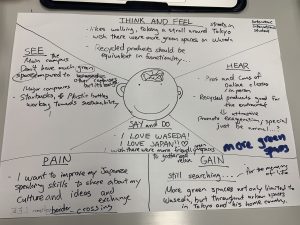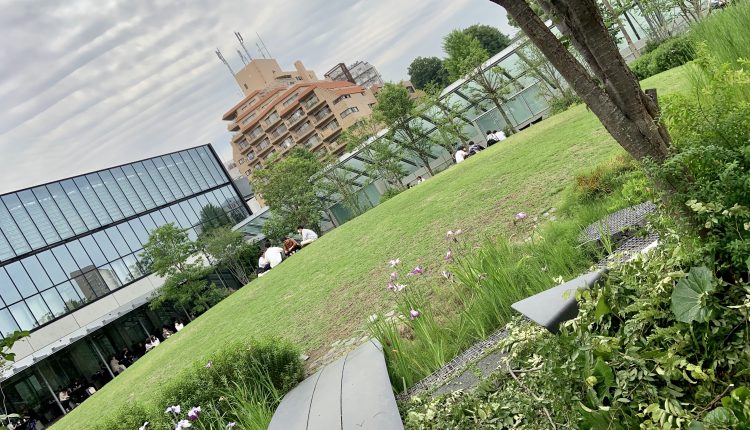Designing the Ideal Sustainable Post-Pandemic University Campus
by Jeong and Michael

Michael and I decided to use two themes for our fieldwork interview, which was
“Designing the ideal Post-pandemic University Campus and Green Sustainable Spaces.”
and “How much more are you willing to pay more for a recycled product? (beverages, clothes, digital devices, etc.)”
The four interviewees that we met were very kind to participate in our interview which was conducted in English and Japanese at Waseda Campus, the Toyama Campus Hill, and Okuma Garden.
In the photo above, I used Interviewee C’s answers to write the empathy map.
🍎🍏Interviewee A and B (Japanese students)
A: Yes, we already have the Okuma garden, but I would love it if there were more green spaces, especially on the Waseda campus. In a green space just like the Toyama campus hill, if the weather is good, I would just eat outside with my friends, and I could just come alone after class just to sit and daydream for a while. After a long day, I would feel relaxed and refreshed being around nature, and it helps even if it’s artificially made on the campus where urban spaces and buildings surround it.
B: More than green spaces, it would be great if there were water spaces in the university like outdoor water fountains and rivers, but it would cost a lot. I like listening to the sound of water because it helps me to stay calm and relaxed. Maybe it would have been better if there was a river around the Okuma Statue (laughs).
A and B: Choosing between buying a recycled and a normal plastic bottle depends on the situation. Instead of buying a recycled plastic bottle at the combine or the vending machines, you could just fill up water in a water bottle and bring it outside. Using your water bottle helps reduce plastic waste as it is sustainable and saves money.
If we’re talking about clothes, I will pay to buy recycled or used clothes. I would pay 20% more for these clothes.
🍇Interviewee C (international student)
The main Waseda campus doesn’t have many green spaces compared to the Toyama campus. I would like it if there were benches or tables in green spaces, so some people do not have to sit on the grass. I actually have never visited the Toyama campus hill, but I heard that there’s a Starbucks and some tables to sit around the hill. I would definitely love to visit there someday since this is my second year at Waseda, and I would love to know more about the university. I like how green spaces like the Okuma garden can be a place where you could come alone or with your friends and just do whatever you want, like sitting on the grass, rest, chatting with your friends, eating lunch, etc. But I wish there were more either outdoor and indoor places inside or around the university to gather.
Recycled products should be equivalent in functionality. We can look at advertisements that promote these products as a “special” or a “different” product compared to regular products that aren’t recycled. I think it’s just like promoting “vegan” products, so although there are intentions to make it attractive and sometimes exaggerated for consumers to feel that they are contributing to the cause by buying recycled products. Companies should make an effort to try to make it the same, just like any other ordinary product.
If I had to choose to buy between a new regular phone and a new phone with a recycled microchip, I would check whether the recycled microchips function well just like a new regular phone. But if the price is a little higher, I would think again about it.
Sustainability with food will be the last thing to worry about. We need to eat, so I don’t want to worry too much about food.
🍍Interviewee D (international student)
I believe that Waseda is already doing a great job building green spaces like the Toyama Campus Hill and Okuma Garden and has more than it needs comparing to other universities in Japan.
Usually, outbreaks of the pandemic tend to strike heavily in densely populated cities with less air ventilation, jointly built buildings, and fewer open spaces.
COVID has created innovations for implementing basic hygiene standards for buildings such as air ventilation and daylight to enter inside. Modern cities around the world started to focus on sustainability. I believe Tokyo is one of the leading role-model cities in Asia striving to create a green, sustainable metropolis. Creating a green, sustainable space within the university could not only refresh air ventilation through greeneries, but it can also improve and calm the mental health of students, staff, and locals through the power of nature. Most of all, all the improvements and focus on health and sanitation regarding living with the pandemic in designing could reduce the death rate and keep people safe.
As a university city for students, Waseda is surrounded by restaurants, cafes, and other public spaces. A university is just like an office placed in the center of the city. COVID-19 has drastically affected the ecosystems within Waseda, and especially restaurants. Restaurants need students who are customers to survive. In a world with/without the virus, we could emphasize creating fluid coexistence of urban residential and outdoor public green spaces, including educational institutions like Waseda, where it would implement the new hybrid online and in-person campus learning style. Networking, meeting new people, enjoying campus life is a crucial part of the university experience. However, the campus could become a place where students will learn inside and outside in the green spaces in the new normal. They will be immersed within Mother Nature and nurture their sensibilities to sustain their mental and physical health and well-being. The coexistence of urban and rural, residential space, and the public space within the university could create a better environment with outdoor green spaces.

